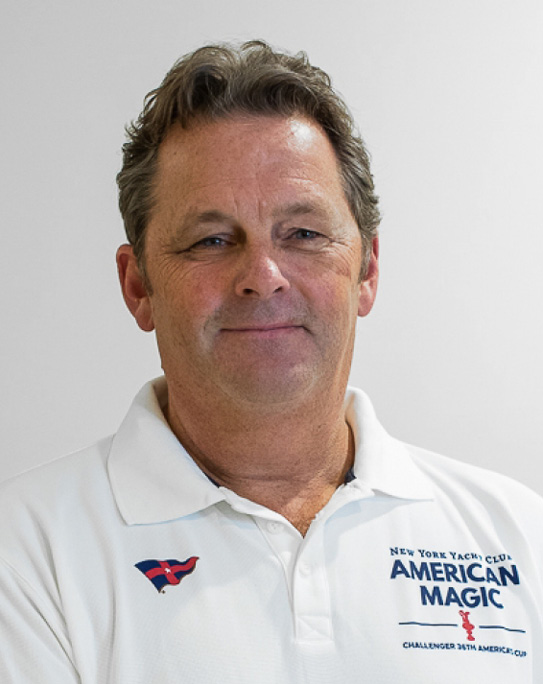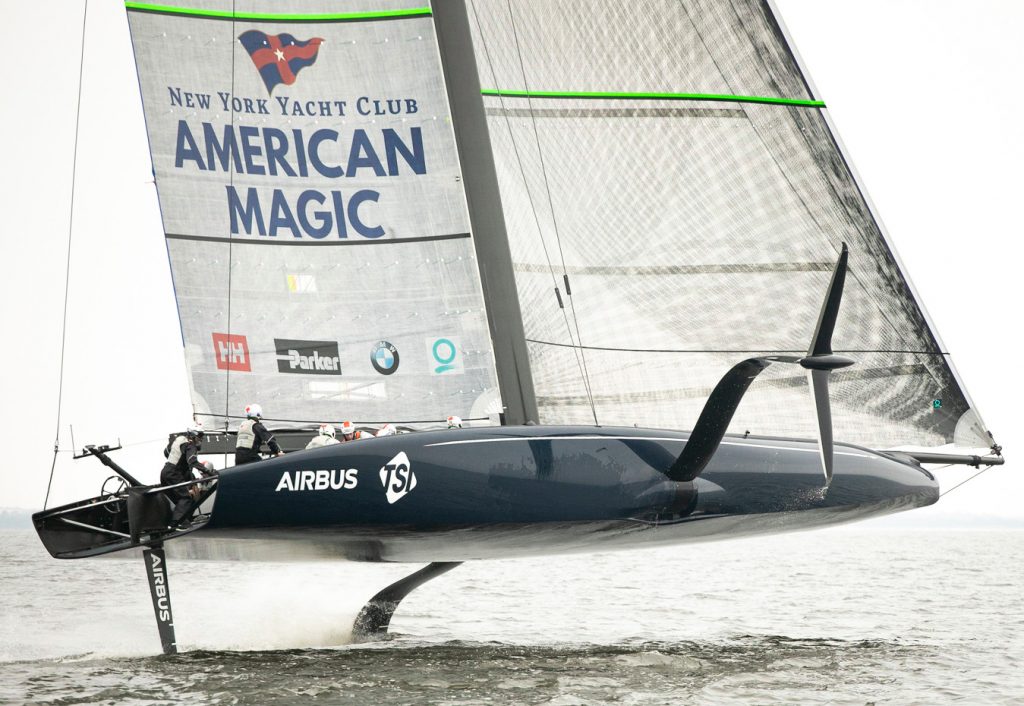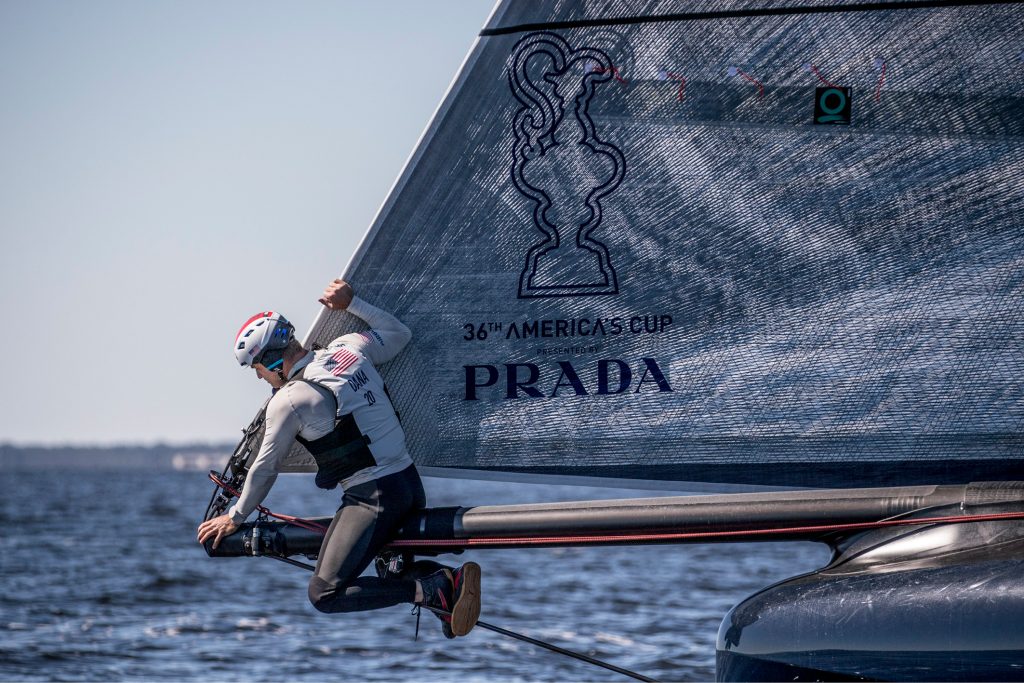
Scott MacLeod
Publisher’s note: I’ve known my good friend Scott MacLeod since I was ten. We grew up at Norwalk Yacht Club in Norwalk, CT. Scott is a three-time collegiate All-American, a former member of the U.S. National Sailing Team, and an excellent team racer. He’s a senior level marketing executive who has created event properties and sold over $100 million in sponsorships across a broad range of sports including golf, tennis, sailing and adventure sports. It was pretty fun to get him to speak recently about the old days and his role with the U.S. challenger for the 36th America’s Cup presented by Prada, scheduled for March 2021.
WindCheck: Where did you grow up, and how old were you when you started sailing?
Scott MacLeod: I grew up in Rowayton, CT. I was twelve when my non-sailing parents threw me into Norwalk Yacht Club’s junior program to keep me occupied for the summer. I really caught the sailing bug at Norwalk YC. There was a great group of about ten of us (including WindCheck Publisher Ben Cesare) that all sailed Lasers competitively amongst ourselves but also had a lot of fun. Bumper boats, sponge tag, funnelators, whales’ tails and raiding other local yacht clubs’ burgees made for a great summer of friends and competition.
The club had a great history of members including Ed Raymond, Skip Raymond, Jack Ritchey and Peter Isler, who had all made a significant mark in the America’s Cup or other events. Bruce Kirby lived right around the corner and would sail his Laser #0 in local events. We were also very lucky to have some great instructors and mentors like Dave Powlison, who were very supportive of our interest in getting better.
The best thing I remember about that time was that we sailed on everything whenever we could. Racing Lasers in junior events, crewing on a Fireball, sailing an overnight race with Jan & Skip Raymond on their Peterson 34, or crewing on the front of a Sonar for Bruce Kirby…lots of very diverse experiences. Kids today seem to be so programmed and regimented that they don’t seem to try different aspects of our sport.

Scott says New York Yacht Club American Magic’s amazing designers and engineers have given the Racing Team a very fast boat in Reliant, pictured in flight near their winter base in Pensacola, FL. © Dylan Clarke/American Magic
WC: Please tell us about your sailing at Tabor, Tulane, and your Finn campaigns.
SM: I ended up doing a PG year at Tabor Academy. Tabor was an awesome experience and allowed me to sail almost every day. Again, we had a great group of sailors under the direction of legend, Toby Baker. Practices were competitive and intense, and helped raise the whole group. I think we won everything that year (Cressy, Mallory, team racing, etc).
My college application process consisted of picking seven schools in the top 20 Inter-Collegiate Sailing Association rankings. Tulane was in the top 10, I had a friend on the team, and I could sail all year long!! I recall calling Ben in the middle of January to say that I’d just gone sailing in 20 knots in shorts and t-shirt while he was freezing his ass off in Boston looking at a frozen solid Charles River! As a freshman coming into Tulane, we had a great group of senior mentors including All-Americans Ralph Kinder, Jens Hookensen and Keith Crum who pushed us young sailors very hard. Tulane didn’t have a coach, so our own qualifying regattas to pick who sailed the next event were very competitive but also taught us how to work as a team and how to manage our own travel, housing and finances.
I did a lot of diverse sailing while at Tulane. I sailed the Kaufman 46 Gauntlet with gold medalist Buddy Friedrichs in the windy GORC Lightship Race in which two people died including my teammate Nelson Roltsch, and racing a J/24 with John Dane and Tom Dreyfus are some of my greatest sailing memories from that time. We also had a great group of Laser sailors at Tulane. We’d would push each other each day and sail non-college Laser events whenever we could. There were lots of road trips across the Southeast which made for some great stories and lifelong friends.
In 1983, after my sophomore year I decided to take a year off and do a one-year Olympic Campaign in the Finn Class. I had borrowed a Finn from Tom Lihan and won a very light air regatta against the top Finn sailors at the time including Tom, Buzz Reynolds, John Bertrand, Kimo Worthington, etc., so I naively thought that I’d made it and this class would be easy. I learned very quickly in my first windy event that the Finn is the toughest boat you’ll ever sail. Tom sold me one of his boats and I spent the winter living in Fort Lauderdale at his mom’s house and sailing at the Lauderdale YC. There were about 15 or 20 sailors training there and sailing every day on the ocean. Sailing a Finn in a 20-knot easterly with the wind against the tide out of Government Cut made for some interesting sailing.
The 1984 Olympic trials were in Long Beach, CA that spring, and the Olympics would be held in the same location that summer. The trials were typical Long Beach 15- to 20-knot seabreeze conditions with big waves. I actually remember leading the first race in about 20 knots and coming down the second reach (yes, reaching legs on the old Olympic course) with John Bertrand hot on my heels. I fell out of the boat when I missed my hiking straps at the leeward mark, managed to get back in without capsizing and finished OK, but it was a huge wake-up call. I finished fourth in the trials but then was moved up to third after Russ Silvestri (who dominated the event) was controversially disqualified for an infraction in the last race.
After the trials I went back to Tulane to finish my next two years, sailing both college events and Finns as part of the US Sailing Team in the summer. I was very lucky to have a pretty good college sailing career, winning two Singlehanded Nationals and a Team Racing Nationals with Steve Bourdow and Matt Fries.
After graduating in ‘86, I did a two-year Olympic Finn campaign which culminated in a bronze medal at the ‘87 Pre-Olympic Regatta in Pusan, Korea. While I had a very bad trials event and didn’t qualify for the Olympic team, the experience was incredible. Traveling across Europe in a van and the Finn Gold Cup in Brazil just before Carnival made for some great stories that probably couldn’t be printed in this magazine!
WC: What kind of sailing are you doing now?
SM: I’ve been doing a lot of team racing, representing Noroton YC on their Masters team. It’s been great to get back into team racing after 20 years and learn some new tricks. I recall asking Karl Ziegler (our coach, skipper and team race guru) about a move and he replied, “That move is so ‘80s.” I knew I had to step up my game, practice and learn. There is a great series of team racing events around the country that culminates in the Big 3 keelboat team race events (Morgan, Hinman and Grandmasters) that the New York YC hosts each summer. The events are really fun, and NYYC does an awesome job hosting them.
I’ve been very lucky to be on a great team with a great group of sailors from Noroton. In the past five years sailing with virtually the same skippers (Tom Kinney and Karl) and crews we’ve won three Hinman Masters and finished second in the other two. Most importantly, it’s great to sail against old college friends and rivals from back in the day.

Newport, Rhode Island’s own Nick Dana on the bow. © Will Ricketson/American Magic
WC: Did you have any significant sailing mentors? If so, what’s the most important thing you learned from him or her?
SM: I’ve been really lucky in that everyone I sailed with was a mentor! The great thing about our sport is that you’re constantly learning and picking up new ideas every time you race. I sailed a lot with Steve Benjamin and Bob Towse on the JV44 Blue Yankee back in the day. They were two of the most competitive people on the planet. No stone unturned, always focused, and second place wasn’t an option. There’s no one better at prepping a boat than Tom Kinney. The attention to detail, set up, and controls made our Sonar racing so easy. Dave Powlison doesn’t know this, but he taught me (and the aforementioned Ben) how to practice and make the most of limited sailing time. While he’s one of the most competitive people on the planet, Bruce Kirby taught me to have fun. Sitting in the front of a Sonar with Bruce and Tor Arneberg was a learning experience and not just about sailing!
WC: What are your responsibilities as New York Yacht Club American Magic’s Commercial Director?
SM: I oversee all of our corporate sponsors, as well as licensing and royalty partners. This includes sales, marketing, contracting and servicing all of our partners at three different levels of commitment. Currently we have 45 partners at various levels of commitment from Airbus as the major partner to Evinrude, one of our suppliers. It’s a great group of partners who have all bought into our team’s effort to win the America’s Cup.
WC: You’ve been involved with sponsorship in sailing for (gulp!) almost 30 years! What has changed over the years, if anything?
SM: It’s still like trying to sell ice to Eskimos, but it’s actually gotten a lot harder. Back in the day, there were fewer options for sponsors to choose from and the CEO could still make an executive decision based on his or her personal preference. I recall when I sold my first title sponsorship to a golf tournament many years ago. We were doing the pitch to the CMO when the CEO popped his head into the meeting and asked, “Now remind me, I get to play with Arnold Palmer in the Pro-Am…right?” We knew at that moment that the deal was done!
Sponsorship these days is scrutinized and analyzed at every level. In addition, there are so many new options to choose from in sports, entertainment and culture. Unfortunately, sailing’s “numbers” have gone down and are just not consistent enough to attract big money in the U.S. In France and a few other countries, it does very well. However, if you price your sponsorship right and create a good story with the target brand, there are still opportunities out there. We recently signed our 45th team sponsor and it shows that there is a keen interest in being part of our effort to win the America’s Cup.
WC: I asked Chief Operating Officer Rob Ouellette if he was surprised by the differences in the first four AC75s launched, and I’ll ask you. What are your thoughts on the approaches taken by the other teams, either financially, commercially or technically…and obviously, with your own very accomplished sailing CV, on their sailing teams?
SM: Being a sailor I was very curious to see the different approaches with the first boats. You can see that Emirates Team New Zealand and Luna Rossa went in a similar direction, which could be because they wrote and had more time with the rule. Ben Ainslie’s boat is very odd looking and doesn’t really appeal to me as a sailor. I believe the second boats will be more similar from a design perspective. In the end, the real story will be in the foil, aero and systems that control the boat that will make the difference. I like where our team sits in this area. We have some amazing designers and engineers!
Commercially, this Cup hasn’t been easy. We’re less than a year out from the event and we still don’t know any of the broadcast details, we’ve cancelled five America’s Cup World Series events, and there’s been no AC racing since 2017. It would be great to get back to an AC like Valencia where we had twelve teams from eleven countries. The campaign costs were reasonable, and the commercial aspects of the event were going in a positive direction.
WC: Please tell us about American Magic’s relationship with the state of Rhode Island and your partnerships with US Sailing, Sail Newport, IYRS School of Technology & Trades, and other Ocean State organizations.
SM: Rhode Island is our home base, so the entire community is very important…especially when we bring the Cup home to Newport. The entire community has been extremely supportive of our team and our effort. Our Principals, the NYYC and our team are truly invested in bringing American sailing back to the America’s Cup.
WC: What’s your advice for young sailors that aspire to race in the America’s Cup?
SM: Dream big and work hard! Do as much sailing in as many boats as you can. We have 140 people on our team, and only 22 sailors. You don’t have to be on the boat to be part of an AC team. Everyone on our team matters and contributes to our performance at every level. You need to be willing to do any job to get started and then work 110%.
WC: Thank you very much Scott. Looking forward to blowin’ the froth off a couple at the victory party in Newport! ■



